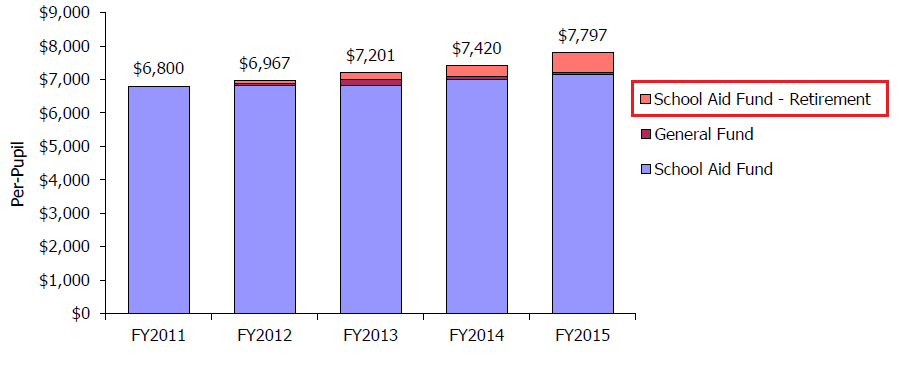
In Michigan, school funding has increased, but schools aren’t seeing much of the money. Instead, most of the funding increases are going toward paying off the state’s retirement debt.
The Citizens Research Council of Michigan (CRC) released a brief documenting changes in the state's education funding over the past five years. The CRC found that state funding for K-12 education has increased by over $1 billion from fiscal years 2011 to 2015. Rather than going toward district resources, like curriculum or teacher salary, almost all of the increased funding is going toward paying off the state’s unfunded pension liabilities which now total over $25 billion. In 2015 alone, Michigan reserved $883 million in order for districts to pay off their employer retirement contributions.
The chart below tracks Michigan’s K-12 education funding in terms of per-pupil spending. The growing pink bars show how retirement funds are increasing, meanwhile the dark purple general fund bars are shrinking and the blue school aid fund bars remain almost stagnant.
State-Funded Per-Pupil Appropriations for K-12 Education, FY 2011 – 2015
Source: Citizens Research Council Memo, “Making Sense of K-12 Education Funding,” October 2014. Senate Fiscal Agency and House Fiscal Agency reports. Excludes early childhood and adult education funding.
In the face of growing pension liabilities, Michigan districts on average were required to set aside 16 to 18 percent of per-pupil spending toward retirement contributions over the past two years. This means for roughly every $7,000 allocated for a student, over $1,000 will go toward paying off pension obligations.
But Michigan isn’t the only state where retirement debt is eating into other school spending. In California, the state teacher pensions plan has an unfunded liability of $74 billion. In order to pay down the current debt, the state increased pension contribution rates that are deducted from a teacher’s paycheck. Within the next decade, nearly 40 percent of California teachers’ total compensation will go toward paying down the pension plan’s unfunded liabilities. Moreover, these costs are rising across the country.
It’s a good thing for states to pay down their pension debt. But in doing so, policymakers need to examine the costs and benefits of the system. Only a small group of teachers will actually reap the benefits of a full-career pension. In Michigan, the state assumes that over half of teachers will not qualify for even a minimum pension. The rising costs come with little reward.
